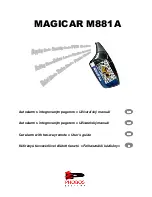
CMS-2 CARBON MONOXIDE MONITOR
Page 5
© 2018 CLEMCO INDUSTRIES CORP.
www.clemcoindustries.com
Manual No. 22925, Rev. I, 04/18
WARNING
The monitor or an auxiliary alarm must be in a
conspicuous place to ensure that any alarm
condition is observed. Using the auxiliary
terminals and a relay, the monitor may be
interlocked with other devices such as the
compressor shut-down, as an additional
safeguard against an unobserved alarm.
2.3.3
Place a tee in the air-supply line, and use a
bushing or other adaptor, to connect one of the 1/4" NPT
tube fittings supplied. Install an isolation valve at the
source to enable depressurization for service and to
remove the monitor. Typical setups are shown in Figure 2.
2.3.4
The tee in the air-supply line should face up to
prevent water from accumulating in the sample–air line.
If the tap cannot face upward, install a drop pipe and
drain to prevent water from entering the monitor.
2.3.5
Connect the other 1/4" NPT tube fitting to the
monitor’s inlet port.
2.3.6
Attach the urethane tubing between the air-
supply tube fitting and monitor-inlet tube fitting. Remove
excess tubing.
2.4 Electrical
Connections
2.4.1 120-Volt AC supply:
A 120-volt AC power cord
is supplied and can be plugged into a compatible AC
grounded electrical service.
2.4.2 220-Volt AC, 50/60-Hz supply:
The only
difference between a 120-volt and 220-volt monitor is the
power cord. Remove the 120-volt cord or plug and
replace it with one that is compatible with a grounded
220-volt receptacle.
2.4.3 12-Volt DC supply:
A DC monitor model is
available from Clemco, or an AC monitor is easily field
converted to operate on 12-volt DC, as noted in Section
2.4.4.
2.4.4 AC to DC field conversion (
Serial No. 4446
and greater)
To convert monitors with serial numbers lower than 4446,
request Manual No. 22925, Revision E or earlier.
The AC power cord provided with the monitor may be
used, using
black
as the positive. A user supplied DC 2-
wire cord may be used, using
red
as positive. If a new
12-volt cord is used, splice the positive through the fuse
and use the spade on the outlet of the fuse to connect to
the positive terminal, as shown Figure 3.
2.4.4.1
Make sure that all electrical power to the monitor
is disconnected.
2.4.4.2
Open the case to access the interior faceplate.
2.4.4.3
Loosen the cover screw located in the center of
the lower edge of the faceplate. Refer to Figure 1.
2.4.4.4
Swing the faceplate up to access the
instrumentation.
2.4.4.5
Remove the connector with
red
and
black
wires
from the plug on the circuit board, as shown in Figure 3.
If there is a chance the monitor will be converted back to
AC power, tie the wires out of the way. If the monitor is
to be permanently converted to 12 volts, pop off the
clear terminal cover and remove the wires from the
terminal.
2.4.4.6
Disconnect the
white
and
black
wires from the
power supply lead wires at the connectors, as shown in
Figure 3.
2.4.4.7
Plug the
black
wire onto the DC+ post at the
lower left corner of the circuit board, as shown in Figure 3.
Note the board is upside down when the cover is open.
Plug the
white
wire onto the DC- post.
Some items removed or rotated for clarity.
Figure
3
2.4.4.8
Remove the plug from the other end of the cord.
DC
DC+
Green Ground Wire
Fuse Assembly
Remove connector.
Connector Plug
Lead Wires
The green ground wire may remain connected or clipped
when using the AC cord for DC applications.
Tie off or
remove wires.
Power Supply
Circuit Board
White wire to DC
Black wire to DC+
Disconnect white and
black wire from
power supply leads.

































